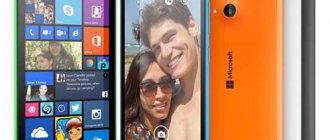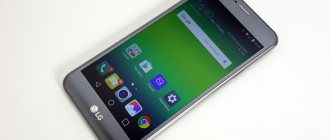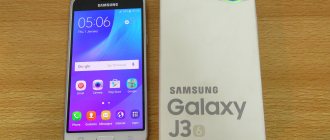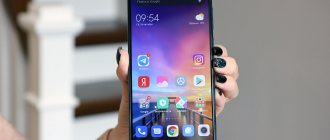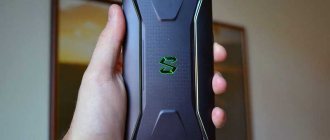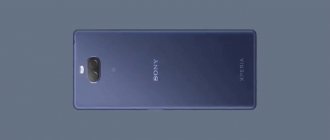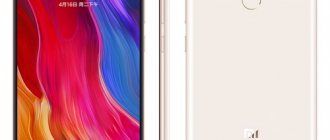Equipment
We can safely say that the packaging has a premium element - solid black. Instead of the usual cardboard, polycarbonate is used. On the front side is the company’s logo and slogan, which reads “Link to the world.”
Put the name of an AAA brand on such a box and show it to people. I would say that there is a device that costs at least $500, which you want to pull out as quickly as possible and start using.
Includes:
• power supply (supports fast charging technology PE+ 2.5A/1.67A(5V/7V/9V) 1.25A(12V)) • USB Type-C cable • instructions • standard pin
The only thing that upsets us is the absence of even the most ordinary, transparent bumper. Still, in online stores you either cannot find a case for this model at all, or in very limited variations with an inflated price tag. Dust instantly gets clogged into the corner with the protruding camera module.
Equipment and weight
The box in which the phone is packaged is entirely plastic, with a translucent lid; it can easily be transported by beloved mail. The previous Super model was packaged in a solid box. It is unknown what the reason for such a “step back” is, but from the manufacturer’s side such a gesture looks ugly. Contents of delivery: 0)
Waste paper
1)
The smartphone itself
2)
USB cable for it
3)
Charger with fast charging technology
4)
Clip for removing the SIM card tray
Design
The appearance of the device is pleasantly surprising. The designers and engineers of UMi really worked hard on this. The body is made of 6000 series aluminum alloy with anodizing process. It creates an oxide, invisible film on the surface, which in this case serves as a protective coating. This is the first time I’ve seen a manufacturer talk in such detail about case materials, so I decided to go to specialized sites on alloys and found out the following information.
In the characteristics of this alloy, three main qualities can be distinguished:
- average strength
- high ductility
- high corrosion resistance in water
By area of application:
- Automotive industry
- marine vessels and installations
- production of transport tanks and wagons
- bicycle building
- construction and architecture
- bridge construction
I am confident that Plus E will surpass all its closest competitors in terms of safety margin. And in your hand you feel a very solid device that you want to show off in any available situation.
There are two sad points:
1) The back cover loves to collect traces of absolutely everything. Wiping on clothes or with a special cloth will bring minimal or no results.
2) The volume rocker and power button are loose. If you shake your smartphone, you can hear the buttons shaking.
Otherwise, I am completely delighted with the truly expensive appearance. Although, the same Elephone also knows how to make its devices beautifully, but the filling leaves much to be desired.
The front side is very reminiscent of flagship solutions from Meizu. In Plus E, under the screen there is both a touch and a mechanical button, and there is also a fingerprint sensor. There are also standard touch buttons “Menu” and “Back”, but you won’t see them because they don’t have any designation. And it looks extremely cool. The strict design of the case is not clogged with unnecessary emblems of under-screen buttons, which is so typical of budget models.
I have already written about the disadvantage of the back side, but there is nothing more to complain about. The camera is located in the center, below is a dual-tone flash and the company logo. At the very bottom is an attempt to replicate the models from Apple. The text is approximately half the same. I would prefer not to write anything at all.
At the top is the headphone input. At the bottom there is a speaker (left), a microphone (right) and a port for USB Type-C. By the way, there is a programmable button on the left side. In the settings you can select any installed program that will launch when clicked, but there is a problem. It does not work when the smartphone is locked.
Fingerprint's scanner
The manufacturer claims a 360-degree fingerprint scanner called Touch ID 2.1 with unlocking in 0.1 second. In practice, things look a little different. On average, 7-8 attempts out of 10 end successfully and the smartphone can be woken up from sleep using a finger. With the screen turned off, unlocking may take a second or even a little more; with the screen turned on, it can take 0.1 seconds.
The manufacturer has not provided any additional functions for the scanner that would help keep personal life secret. For example, as Huawei does.
Display
I fell in love with the UMi Plus E screen at first sight. The smartphone conveys such a realistic color scheme without going into yellow tones that you get real pleasure from watching any content, and your eyes don’t get tired at all even after several hours. The matrix, produced by Sharp, is built using IPS LTPS technology, that is, without an air gap. In the photo below, the UMi screen is the larger one, and the Lenovo Vibe X2 is the smaller one.
Unfortunately, the developer skimped on the protective glass and installed a panel not from Corning, which produces the Gorilla Glass series, but from Dinorex.
The glass is called T2X-1 Glass. The same model is found in the Meizu M3 Note smartphone. My opinion is that this is a dubious decision, because almost nothing is known about the company, and even more so about the quality of the glass. The 2.5D effect is very pronounced on the front side and is pleasing to the eye. I like it when they try to smooth out the edges as much as possible; this only makes the smartphone more laconic.
- 5.5 inches
- resolution 1920x1080 pixels
- dot density 401 ppi
The oleophobic coating on the glass is excellent. Traces of use are barely noticeable and can be easily wiped off.
Camera
UMi Plus has a 13MP camera installed (they promise it’s from Samsung) with PDAF support, which means that UMi Plus should focus on objects very quickly, which was experimentally tested by me; it feels like image capture happens in a second in automatic mode. But when shooting moving objects, they are quite blurred, which seems to not be the case with PDAF technology (maybe in the future they will somehow fix it in software).
UMi Plus has a manual shooting mode. You can’t do this in a couple of seconds, there are a lot of settings and if time allows, you can take a beautiful photo.
Examples of photos of UMi Plus in auto mode:
Examples of Umi Plus videos:
There are controversial reviews about the UMi Plus camera, on the one hand it is not bad, you can get a good picture with it, but it also does not always guess the white balance and the focus may be wrong. This happens with many smartphones; if you want really good pictures, buy a DSLR.
Technical characteristics of UMi Plus E
- MediaTek Helio P20 processor 8 cores Cortex-A53, up to 2.3 GHz (model MT6757, 16 nm, 64-bit)
- graphics Mali-T880 MP2 900 MHz
- RAM 6 GB LPDD4 (after reboot free around 4 GB)
- 64 GB data storage (52 GB available out of the box), manufactured by Samsung using eMMC5.1 technology
- Supports Micro SD memory cards up to 256 GB
- Sharp 5.5-inch IPS LTPS display with 1920 x 1080 resolution, no air gap
- front camera 5 MP GalaxyCore GC5005 (aperture f/2.8, one pixel 1.12 microns, maximum recording quality 480p)
- main camera 13 MP Samsung S5K3L8 (f/2.0 aperture, one 1.12 micron pixel, 1/3.06” matrix size, PDAF focusing, 1080p and 4K video recording)
- battery 4000 mAh (2.5A / 1.67A (5V/7V/9V) 1.25A (12V))
- OS Android 6.0.1
- without any shell
- audio chip AW8738
- Sensors: accelerometer, light and distance sensor, digital compass, gyroscope, fingerprint scanner
- Connectors: Type-C USB (OTG works), 3.5 mm audio port
- dimensions: 155x 75 x 8.8 mm
- weight 185 grams
Wireless capabilities:
- 2G, 3G, 4G LTE Cat. 4 (bands: 1, 3, 7, 20)
- support for two SIM cards (Micro type)
- Wi-Fi (802.11 a/b/g/n, 2.4 GHz/5 GHz), Bluetooth 4.1, Beidou, FM radio
- Navigation: GPS, Glonass
The only thing that upsets me about the technical specifications is the lack of NFC, as well as the ability to shoot video with the front camera in 480p. The situation is further aggravated by the introduction on the official page of UMi Plus E with the slogan “Breaking into 2020.” Well, we don’t need recording in this quality, even with a front camera, in 2020!
By the way, this was the first announced device on the Helio P20 platform, which should be 25% faster than its predecessor. But don’t forget that MediaTek’s P family consists of energy-efficient processors rather than high-performance ones, so the closest competitor is the Qualcomm Snapdragon 653. Coupled with a 4000 mAh battery, you can expect a super long autonomy of the smartphone, which I tested during the week. Frankly, I was dumbfounded by the results, but more on that later.
Umi Plus smartphone review
The device is from a little-known Chinese manufacturer, interesting, but not without its shortcomings
Content
- Specifications
- Equipment
- Appearance and ease of use
- Screen
- Camera
- Telephone and communications
- Software and multimedia
- Performance
- Thermal photographs
- Playing video
- Battery life
- Bottom line
The Umi company, which sells smartphones under its own brand, is not one of the most popular Chinese manufacturers, and in general, as they say, there are not enough stars in the sky. The brand also does not have its own production; it orders the production of smartphones externally. Now, among the new products, Umi has a model called Umi Plus - the name is laconic and understandable, designed to show the status of the model in the line, and perhaps in the entire range. We were interested to know what level Umi is ready to demonstrate against the backdrop of fierce competition between Chinese manufacturers. Read the review of a smartphone called Umi Plus to see what came of it.
Main characteristics of Umi Plus
- SoC MediaTek Helio P10 (MT6755M), 8 cores ARM Cortex-A53: [email protected] .8 GHz and [email protected] GHz
- GPU ARM Mali-T860 MP2 @700 MHz
- Operating system Android 6.0
- Touch display IPS 5.5″, 1920×1080, 401 ppi
- Random access memory (RAM) 4 GB, internal memory 32 GB
- Micro-SIM support (2 pcs.)
- MicroSD support up to 256 GB
- GSM/GPRS/EDGE networks (850/900/1800/1900 MHz)
- WCDMA/HSPA+ networks (850/900/1900/2100 MHz)
- Networks LTE cat.4 FDD Band 1/3/7/20
- Wi-Fi 802.11a/b/g/n/ac (2.4 and 5 GHz)
- Bluetooth 4.1
- GPS, A-GPS, Glonass
- USB Type-C, USB OTG
- Camera 13 MP, autofocus, f/2.0, video 1080p
- Front camera 5 MP, f/2.0, fixed. focus
- Proximity sensor, lighting sensor, magnetic field sensor, fingerprint sensor, accelerometer, gyroscope, step counter
- Audio chip AW8738
- Battery 4000 mAh
- Dimensions 156×76×8.9 mm
- Weight 192 g
| average price |
| T-14221176 |
| Retail offers |
| L-14221176-10 |
Contents of delivery
Umi Plus is sold in a very compact and nice box made of matte, slightly rough plastic with a translucent lid. It’s quite unexpected to find such stylish packaging on an inexpensive smartphone, made not from ordinary cardboard, but from plastic. However, this also happens sometimes.
The kit consists of a powerful network adapter with variable maximum output current and voltage (5/7/9/12 V; 1.67/1.25 A), a USB Type-C connecting cable and a key for removing cards. There was nothing else in the small box.
Appearance and ease of use
Umi Plus has a metal case with a slightly strange design: the plump, as if blown case has clearly defined chamfers on the side rim, so there is no completely smooth, “rounded” transition from the back and front to the sides. Typically, such chamfers are made on cases with flat edges, the smartphone gets chopped features, but here, in the end, the case turned out to be not as attractive as it could have been. However, these are our quibbles, and in general the metal Umi Plus from a distance is not much different from its modern Chinese counterparts.
In the photo from left to right: Umi Plus, Xiaomi Redmi Note 4, Meizu MX6
True, upon closer examination, Xiaomi’s desire, for example, to make a body with chopped features is clearly visible; most of the edges of its device are absolutely flat, and the rounding of the back side is small and only along one axis. Meizu, on the contrary, made a “remnant” that is symmetrical and streamlined on all sides without flat edges or any chamfers; a certain style can also be seen here. But in Umi Plus these two styles merged together, resulting in a not entirely clear “porridge”. And in any case, Umi Plus came out too “inflated” in appearance.
The front panel corresponds to this feeling no less than the back. The effect of the rounded edges of the 2.5D glass used here is enhanced by a thick plastic spacer, which lifts the glass high above the body and is a logical continuation of its sloping edges, making the glass visually even more convex.
The case is not easily soiled, but quite slippery to hold in your hand. This is facilitated by the rounded shape of the thick body, as well as its rather large mass. Because of all this, the voluminous and weighty smooth metal body tends to slip out of your hand.
There are also certain complaints about the assembly: as in Doogee products, there are minor defects that spoil the whole impression. Metal slides with cards, for example, do not want to fit tightly into the connector the first time; to do this, you need to adjust them with force each time and then insert them all the way. Small thing, but annoying. Taking into account the fact that the company does not have its own production, the question arises: who made this device for Umi?
But there are more serious problems. Like the Doogee F7 Pro, here the USB Type-C connector is made so deep that only the supplied cable reaches the contacts - none of the third-party ones we tried worked. Accordingly, we could not even check the presence or absence of support for connecting external devices to this connector, since all the OTG adapters we have simply do not come into contact with the smartphone connector. Again, if something happens to the supplied cable, it will be very difficult to find a replacement for it.
The camera module on the back of the smartphone protrudes beyond the surface of the case, causing the device lying on the table to sway slightly when you touch the screen. The camera is accompanied by an LED flash consisting of two multi-colored LEDs; the flash is quite bright.
The front panel is completely covered with protective 2.5D glass with sloping edges. There is an LED event indicator in the upper part above the screen, and a full set of necessary sensors installed right there, next to the speaker grille.
Under the screen there is a built-in mechanical key with a fingerprint scanner embedded in it. The scanner is not bad in response time and recognition quality. You can put your finger on it at any angle. Pressing the button takes you to the home screen. There are no other hardware buttons next to it - the rest of the buttons are virtual, they are displayed on the screen. The panel with buttons can be hidden and brought back, and you can also change the order of the buttons on the panel.
The side keys are perhaps a little less rigid than we would like, but in general you can get used to it. The dimensions and their relative positions are quite standard, there are no problems with this: the buttons are conveniently located and can be easily felt blindly.
The card slot is designed for SIM cards in Micro-SIM format. Coupled with the described problem with the stuck sled, installing a Nano-SIM with adapters here turns into a real torment. The connector is hybrid; instead of one of the SIM cards, you can install a microSD memory card. Hot swap supported. On the same edge there is another button that can be configured to perform any of a variety of functions.
The USB Type-C connector is installed on the bottom end in the center; two groups of holes are symmetrically cut out on either side of it, but only through one of them does the sound of the main speaker come out; there is no stereo sound here. In general, the Umi Plus sounds quite modest, both through the main speaker and through connected high-quality headphones. The sound in the speaker is very loud, but thin and squeaky, low frequencies are not heard, the sound is simple. Unfortunately, the sound in the headphones is not impressive either (Meizu HD50 was used for testing), although the smartphone, like previous Umi models, is equipped with a dedicated AW8738 audio chip.
The 3.5 mm headphone jack is embedded in the top end. The hole for the second, auxiliary microphone is also located in the upper part of the body, but just below the end, on the back side.
The smartphone is available for sale in two color options: dark gray and gold. In both cases, the front panel under the glass remains black, which doesn’t look very good on the gold version (white would be more appropriate here).
Screen
Umi Plus is equipped with an IPS touch display with protective 2.5D glass with sloping edges. The physical dimensions of the screen are 68x121 mm, diagonal - 5.5 inches, resolution - 1920x1080 pixels, pixel density is approximately 401 ppi. The frame around the screen is peculiar: on the sides it is quite narrow, only about 3.5 mm, but at the top and bottom the indents are quite wide, they are approximately 17 mm each, which makes the smartphone body more elongated than most analogues.
The display brightness can be adjusted manually or automatically adjusted based on the ambient light sensor. The AnTuTu test diagnoses support for 5 simultaneous multi-touch touches.
A detailed examination using measuring instruments was carried out by the editor of the “Monitors” and “Projectors and TV” sections Alexey Kudryavtsev
. Here is his expert opinion on the screen of the sample under study.
The front surface of the screen is made in the form of a glass plate with a mirror-smooth surface that is scratch-resistant. Judging by the reflection of objects, the anti-glare properties of the screen are slightly worse than those of the Google Nexus 7 (2013) screen (below, simply Nexus 7). For clarity, here is a photograph in which a white surface is reflected in the switched off screens (on the left - Nexus 7, on the right - Umi Plus, then they can be distinguished by size):
The screen of the Umi Plus is a little brighter (brightness according to photographs is 106 versus 99 for the Nexus 7). The ghosting of reflected objects in the Umi Plus screen is weak, this indicates that there is no air gap between the layers of the screen (more specifically, between the outer glass and the surface of the LCD matrix) (OGS - One Glass Solution type screen). Due to the smaller number of boundaries (glass/air type) with very different refractive indices, such screens look better in conditions of intense external illumination, but their repair in the case of cracked external glass is much more expensive, since the entire screen has to be replaced. On the outer surface of the screen, there is a special oleophobic (grease-repellent) coating, which is better in efficiency than that of the Nexus 7. Therefore, fingerprints are removed much easier and appear at a lower speed than in the case of regular glass.
When manually controlling the brightness and displaying the white field in full screen, the maximum brightness value was about 450 cd/m², the minimum was 15 cd/m². The maximum brightness is quite high, and, given the good anti-glare properties, readability even on a sunny day outdoors should be at a good level. In complete darkness, the brightness can be reduced to a comfortable value. There is automatic brightness adjustment based on the light sensor (it is located to the left of the front speaker slot). In automatic mode, as external lighting conditions change, the screen brightness both increases and decreases. The operation of this function depends on the position of the brightness adjustment slider. If it is 100%, then in complete darkness the auto-brightness function reduces the brightness to 140 cd/m² (very bright), in an office illuminated by artificial light (about 550 lux) it sets it to 380 cd/m² (also quite bright), in a very bright environment (corresponds to lighting on a clear day outdoors, but without direct sunlight - 20,000 lux or a little more) brightness increases to 450 cd/m² (to the maximum, which is what is needed); if the slider is at about 50%, then the values are as follows: 12, 280 and 450 cd/m² (the average value is still too high), the slider at 0% is 2, 100 and 450 cd/m² (the first value is too low, the rest are normal). It turns out that the auto-brightness function does not work quite adequately.
At any brightness level, there is no significant backlight modulation, so there is no screen flicker.
This smartphone uses an IPS matrix. In the micrograph you can see a typical IPS subpixel structure:
For comparison, you can see the gallery of microphotographs of screens used in mobile technology.
The screen has good viewing angles without significant color shift even with large viewing deviations from perpendicular to the screen and without inverting shades. For comparison, here are photographs in which the same images are displayed on the screens of Umi Plus and Nexus 7, while the brightness of the screens is initially set to approximately 200 cd/m², and the color balance on the camera is forcibly switched to 6500 K.
There is a white field perpendicular to the screens:
Note the good uniformity of brightness and color tone of the white field.
And a test picture:
The color saturation on the Umi Plus screen is natural, and the color balance is noticeably different from the comparison screen.
Now at an angle of approximately 45 degrees to the plane and to the side of the screen:
It can be seen that the colors have not changed much on both screens, but on the Umi Plus the contrast has decreased to a greater extent due to the strong brightening of black.
And a white field:
The brightness at an angle of the screens decreased (at least 5 times, based on the difference in shutter speed), and decreased approximately equally. When deviated diagonally, the black field brightens greatly, but remains a conditionally neutral gray hue. The photographs below demonstrate this (the brightness of the white areas in the direction perpendicular to the plane of the screens is the same!):
And from another angle:
When viewed perpendicularly, the uniformity of the black field is good, although not ideal (here the Umi Plus screen has the brightness set to maximum):
The contrast (approximately in the center of the screen) is high - about 1000:1. The black-white-black response time is 27 ms (13 ms on + 14 ms off). The transition between halftones of gray 25% and 75% (based on the numerical value of the color) and back takes a total of 39 ms. The gamma curve, constructed using 32 points with equal intervals based on the numerical value of the shade of gray, did not reveal any blockage in either the highlights or the shadows. The exponent of the approximating power function is 2.89, which is higher than the standard value of 2.2, but in this case this does not mean anything - see below. In this case, the real gamma curve strongly deviates from the power-law dependence:
Due to the dynamic adjustment of the backlight brightness in accordance with the nature of the displayed image (in dark areas the brightness decreases), the resulting dependence of brightness on hue (gamma curve) does not correspond to the gamma curve of a static image, since the measurements were carried out with sequential output of shades of gray on almost the entire screen . For this reason, we carried out a number of tests - determining contrast and response time, comparing black illumination at angles - when displaying special templates with a constant average brightness, and not monochromatic fields in the entire screen. In general, non-disabled brightness correction does nothing but harm, since it reduces the visibility of gradations in shadows in the case of dark images, as well as the readability of the screen in bright light, and constant changes in screen brightness can cause discomfort for the user.
The color gamut is slightly different from sRGB:
The spectra show that the matrix filters moderately mix the components with each other:
However, the deviations of the coordinates of the primary colors from the vertices of the sRGB triangle are small, so visually the colors on this screen practically do not differ from natural ones. The balance of shades on the gray scale is acceptable, since the color temperature may be higher than the standard 6500 K, but the deviation from the blackbody spectrum (ΔE) is less than 10, which is considered a good indicator for a consumer device. At the same time, color temperature and ΔE change little from hue to hue - this has a positive effect on the visual assessment of color balance. (The darkest areas of the gray scale can be ignored, since color balance there is not very important, and the error in measuring color characteristics at low brightness is large.)
This device has a fairly advanced system of profiles and settings, which provides the ability to adjust color balance, etc. It’s called MiraVision
.
In the graphs above, the curves are Without corr.
correspond to the results without any color balance correction, and the
Heat
correspond to the data obtained after shifting the color temperature correction slider to the extreme “warmest” position. It can be seen that the change in balance corresponds to the expected result, since the color temperature approached the standard value, but ΔE increased significantly. There is no particular point in making corrections.
To summarize: the screen has a fairly high maximum brightness and has good anti-glare properties, so the device can be used outdoors even on a sunny summer day. For conditions of complete darkness, it is possible to set a comfortable brightness level. There is also a mode with automatic brightness adjustment, which, however, does not work quite adequately. The advantages of the screen include the absence of an air gap in the layers of the screen and flicker, an effective oleophobic coating, acceptable color balance, and a color gamut close to sRGB. Significant disadvantages include the low stability of black to the deviation of the gaze from perpendicular to the screen plane, as well as the non-disabled dynamic adjustment of the backlight brightness. Taking into account the importance of the characteristics for this particular class of devices, we can assume that the screen quality is at least above average.
Camera
The smartphone is equipped with two digital camera modules with a resolution of 13 and 5 megapixels. The front module has a GalaxyCore GC5005 sensor with a resolution of 5 megapixels and a lens with an f/2.0 aperture with a fixed focus and without its own flash. The quality of shooting, even for selfie level, is modest; a high-quality self-portrait against the backdrop of landmarks may not be possible using the front camera. The dynamic range is narrow, there is a problem typical for such a situation: if you point at the face, the sky disappears; if you point at the sky, the face turns black.
The main camera has a 13-megapixel Samsung 3L8 sensor and an f/2.0 aperture lens. Phase detection autofocus is quite fast, the flash is bright, there is no electronic stabilization.
The control menu here, despite the “naked” Android, is non-standard, it is clear and much more convenient than the standard Google menu. All functions are distributed on one screen in separate square cells; a similar menu was once used in LG smartphones. There is also a manual settings mode, in which, using semicircular sliders, you can adjust and set exposure, ISO, white balance, brightness, and contrast. You cannot transfer control of camera settings to third-party applications using the Camera2 API, and there is also no possibility of recording in RAW.
The camera can shoot video in a maximum resolution of 1080p; there are no 4K or 60 fps modes. There is no electronic stabilization function; it is impossible to shoot smoothly and without jerks on the move. And yet, in general, the camera copes well with video shooting: the sharpness, color rendition and detail of the image are normal. The sound is recorded sensitively, but the noise reduction system sometimes does not cope well with the surrounding noise, which is why a good video may not receive the best sound accompaniment.
- Video No. 1 (38 MB, 1920× [email protected] fps, H.264, AAC)
- Video No. 2 (29 MB, 1920× [email protected] fps, H.264, AAC)
Below are examples of photographs with our comments on quality. Our specialist Anton Soloviev
.
| The camera copes poorly with macro photography. |
| The sharpness in mid-grounds is not very good, but the program tries to work out the details. |
| Good sharpness across the frame except for the left edge. |
| The text is well done only in places. |
| Despite the abundance of noise, small details in distant plans are worked out normally. |
| Often the camera fails to work even close-ups. |
Most likely, having installed the camera in a smartphone, the manufacturer did not bother much about adapting it. It's surprising that sometimes a raw module still produces good results. There are shortcomings in everything: unprocessed noise and noise reduction that somehow works in places, strange sharpening that hits the target every once in a while, large areas of blur. You can still shoot with a camera, but the pictures are taken every once in a while, and the result is still below average.
Telephone and communications
The network capabilities of Umi Plus are quite good, since, unlike most similar Chinese smartphones, our hero fully supports all three of the most common LTE FDD frequency bands in our country (Band 3, 7 and 20).
- GSM: 850(B5)/900(B8)/1800(B3)/1900(B2)
- WCDMA: 850(B5)/900(B8)/1900(B2)/2100(B1)
- LTE FDD: 2100(B1)/1800(B3)/2600(B7)/800(B20)
The rest of the features are standard for a modern Chinese smartphone: there is no NFC, but two Wi-Fi bands are supported (2.4 and 5 GHz), there is Wi-Fi Direct, and you can organize a wireless access point via Wi-Fi or Bluetooth 4.1 channels. The USB Type-C connector should support connecting external devices in USB OTG mode, but we were unable to test this in practice due to the connector being too deep, with which only the supplied cable “contacts”.
The navigation module works with both GPS (with A-GPS) and the domestic Glonass. The sensitivity and speed of the navigation module are not surprising: the first satellites during a cold start in the absence of a wireless network for data transmission are detected in 2-3 minutes. The smartphone is equipped with a magnetic field sensor, on the basis of which the digital compass of navigation programs usually operates.
The phone application supports Smart Dial, that is, while dialing a phone number, a search is immediately carried out by the first letters in contacts. The standard keyboard does not support Swype-type stroke input by default.
In conversational dynamics, the voice of a familiar interlocutor remains recognizable, although the sound is rough and dull. The recorder does not record sound very well, close rustling turns into loud noise, and the voice of the interlocutor from two meters is barely audible. FM radio is present in the device and only works with headphones connected as an antenna. The vibration motor is quite noisy during operation and vibrates quite noticeably.
The smartphone supports dual SIM cards. The standard interface allows you to select a specific card for each function in advance or directly during the connection. Work with two SIM cards is organized according to the usual Dual SIM Dual Standby standard, when both cards can be in active standby mode, but cannot work at the same time - there is only one radio module.
OS and software
The device uses the Google Android 6.0 software platform as a system, although Umi proudly announced that Umi Plus will be the first device on the MTK Helio P10 platform to support the latest version of Android 7.0 OS. At the time of writing this review, such an update had not arrived for the smartphone, and in stores it is sold with Android 6. There is no full-fledged alternative interface here; the creators point out that among the advantages of their model is the presence of a “pure” Android OS.
There are still minor differences (more precisely, additions), and they are clearly noticeable, since it is the additional sections of the settings that are not translated into Russian even in the Russian version of the interface. This applies to the settings for controlling the additional hardware button on the left side, as well as the functions for controlling the event light indicator, power consumption and the set of buttons on the hidden panel. Otherwise, this is an almost pure, “stock” version of Android 6.0. Applications are not installed on the memory card.
The standard Google Music audio player is designed for listening to music; among the manual settings, it has a standard equalizer with preset values. You can also influence the sound using BesAudEnh (headphones) and BesLoudness (speaker) sound enhancement settings, standard for systems on MediaTek platforms.
Performance
The Umi Plus hardware platform is based on the MediaTek MT6755 SoC, also known as Helio P10. The Helio P10 configuration includes a 64-bit octa-core True8Core processor based on the ARM Cortex-A53 architecture, operating at up to 2 GHz, and an ARM Mali-T860 graphics processor, operating at 700 MHz. True, it uses a modification of the MT6755M with a core frequency reduced to 1.8 GHz; this is the version of the SoC in smartphones that is more common than the full-fledged one.
The amount of RAM is 4 GB, built-in flash memory is 32 GB, of which about 25 GB is initially available to the user for his needs. This volume can be increased using microSD cards. MicroSD cards are supported up to 256GB in capacity, and in practice our review Transcend Premium microSDXC UHS-1 128GB card was successfully recognized by the device.
MediaTek Helio P10 is a mid-level platform, its capabilities are not outstanding, but they are still quite sufficient to perform most of the tasks posed to a modern mobile assistant. This SoC does not provide high numbers in benchmarks, but quite confidently copes with any tasks, including demanding games. Even the rather capricious Dead Trigger 2 runs without slowdowns, not to mention less demanding games like World of Tanks, which can be played comfortably on the Umi Plus.
Testing in the latest versions of comprehensive tests AnTuTu and GeekBench:
For convenience, we have compiled all the results we obtained when testing the smartphone in the latest versions of popular benchmarks into tables. The table usually adds several other devices from different segments, also tested on similar latest versions of benchmarks (this is done only for a visual assessment of the obtained dry figures). Unfortunately, within the framework of one comparison it is impossible to present the results from different versions of benchmarks, so many worthy and relevant models remain “behind the scenes” - due to the fact that they once passed the “obstacle course” on previous versions of test programs.
| Umi Plus (MediaTek Helio P10) | Xiaomi Redmi Note 4 (MediaTek Helio X20) | LeEco Le 2 (Qualcomm Snapdragon 652) | Doogee T6 Pro (MediaTek MT6753) | |
| AnTuTu (v6.x) (bigger is better) | 48490 | 69556 | 79757 | 37062 |
| GeekBench (v4.x) (bigger is better) | 682/2603 | 1540/2781 | 1460/2660 | 596/2420 |
Testing the graphics subsystem in gaming tests 3DMark, GFXBenchmark and Bonsai Benchmark:
When testing in 3DMark, the most powerful smartphones now have the ability to run the application in Unlimited mode, where the rendering resolution is fixed at 720p and VSync is disabled (which can cause the speed to rise above 60 fps).
| Umi Plus (MediaTek Helio P10) | Xiaomi Redmi Note 4 (MediaTek Helio X20) | LeEco Le 2 (Qualcomm Snapdragon 652) | Doogee T6 Pro (MediaTek MT6753) | |
| 3DMark Ice Storm Sling Shot (bigger is better) | 415 | 569 | 812 | 198 |
| GFXBenchmark Manhattan ES 3.1 (Onscreen, fps) | 5 | 6 | 9 | 7 |
| GFXBenchmark Manhattan ES 3.1 (1080p Offscreen, fps) | 5 | 5 | 9 | 3 |
| GFXBenchmark T-Rex (Onscreen, fps) | 17 | 15 | 24 | 19 |
| GFXBenchmark T-Rex (1080p Offscreen, fps) | 17 | 14 | 31 | 12 |
Browser cross-platform tests:
As for benchmarks for assessing the speed of the javascript engine, you should always make allowance for the fact that their results significantly depend on the browser in which they are launched, so the comparison can only be truly correct on the same OS and browsers, and this is possible during testing not always. For Android OS, we always try to use Google Chrome.
| Umi Plus (MediaTek Helio P10) | Xiaomi Redmi Note 4 (MediaTek Helio X20) | LeEco Le 2 (Qualcomm Snapdragon 652) | Doogee T6 Pro (MediaTek MT6753) | |
| Mozilla Kraken (ms, less is better) | 9808 | 11100 | 3710 | 13195 |
| Google Octane 2 (bigger is better) | 3994 | 3660 | 9486 | 2694 |
| SunSpider (ms, less is better) | 1179 | 1384 | 587 | 1701 |
AndroBench memory speed test results:
Thermal photographs
Below is a thermal image of the rear
surface obtained after 10 minutes of battery testing in the GFXBenchmark program:
It can be seen that the heating is highly localized in the upper right part of the device, which apparently corresponds to the location of the SoC chip. According to the heat chamber, the maximum heating was 38 degrees (at an ambient temperature of 24 degrees), which is not very much.
Playing video
To test the omnivorous nature of video playback (including support for various codecs, containers and special features, such as subtitles), we used the most common formats, which make up the bulk of the content available on the Internet. Note that for mobile devices it is important to have support for hardware video decoding at the chip level, since it is most often impossible to process modern options using processor cores alone. Also, you shouldn’t expect a mobile device to decode everything, since the leadership in flexibility belongs to the PC, and no one is going to challenge it. All results are summarized in a table.
According to the testing results, the test subject was not equipped with all the necessary decoders that are needed to fully play most of the most common multimedia files on the network, in this case, audio files. To successfully play them, you will have to resort to the help of a third-party player - for example, MX Player. True, it is also necessary to change the settings and manually install additional custom codecs, because now this player does not officially support the AC3 sound format.
| Format | Container, video, sound | MX Video Player | Standard video player |
| BDRip 720p | MKV, H.264 1280×720, 24fps, AAC | plays normally | plays normally |
| BDRip 720p | MKV, H.264 1280×720, 24fps, AC3 | The video plays fine, there is no sound | The video plays fine, there is no sound |
| BDRip 1080p | MKV, H.264 1920×1080, 24fps, AAC | plays normally | plays normally |
| BDRip 1080p | MKV, H.264 1920×1080, 24fps, AC3 | The video plays fine, there is no sound | The video plays fine, there is no sound |
Further testing of video playback was performed by Alexey Kudryavtsev
.
We were unable to check the theoretically possible support for adapters for outputting images to an external device due to the lack of an adapter option that connects to the USB Type-C port, so we had to limit ourselves to testing the output of video files to the screen of the device itself. To do this, we used a set of test files with an arrow and a rectangle moving one division per frame (see “Method for testing video playback and display devices. Version 1 (for mobile devices)”). Screenshots with a shutter speed of 1 s helped determine the nature of the output of frames of video files with various parameters: the resolution varied (1280 by 720 (720p), 1920 by 1080 (1080p) and 3840 by 2160 (4K) pixels) and frame rate (24, 25, 30, 50 and 60 fps). In the tests we used the MX Player video player in the “Hardware” mode. The test results are summarized in the table:
| File | Uniformity | Passes |
| 4K/30p | cannot be played | |
| 4K/25p | cannot be played | |
| 4K/24p | cannot be played | |
| 1080/60p | Badly | a lot of |
| 1080/50p | Great | No |
| 1080/30p | Great | No |
| 1080/25p | Fine | No |
| 1080/24p | Fine | No |
| 720/60p | Badly | a lot of |
| 720/50p | Great | No |
| 720/30p | Great | No |
| 720/25p | Fine | No |
| 720/24p | Great | No |
Note: If both columns have Uniformity
and
Skips
are given green ratings, this means that, most likely, when watching films, artifacts caused by uneven alternation and skipping of frames will either not be visible at all, or their number and visibility will not affect the viewing comfort. Red marks indicate possible problems with playback of the corresponding files.
According to the frame output criterion, the quality of playback of video files on the screen of the smartphone itself is good, since in most cases frames (or groups of frames) can (but are not required) be output with more or less uniform alternation of intervals and without skipping frames. Note that in the case of 60 fps files, at least 6 frames per second are skipped, and in a row. The reason is the atypically low screen refresh rate of 54 Hz. When playing video files with a resolution of 1920 by 1080 pixels (1080p) on a smartphone screen, the image of the video file itself is displayed exactly along the border of the screen, one to one in pixels, that is, in the original resolution. The brightness range displayed on the screen corresponds to the standard range of 16-235: in the shadows only a couple of shades merge with black, and in the highlights all gradations of shades are displayed.
Battery life
The non-removable battery installed in the Umi Plus has a decent capacity of 4000 mAh. Accordingly, nothing prevented the hero of the review from demonstrating a quite decent level of autonomy; in this regard, there is not the slightest complaint about the smartphone. In real-life usage scenarios, the device demonstrates much better battery life than most smartphones of its level.
Testing was traditionally carried out at the usual level of power consumption, but the smartphone also has a standard power saving mode.
| Battery capacity | Reading mode | Video mode | 3D Game Mode | |
| Umi Plus | 4000 mAh | 17:30 | 15:00 | 5:00 a.m. |
| Xiaomi Redmi Note 4 | 4000 mAh | 12:00 pm | 10:00 am | 4:00 am |
| Leeco Le 2 | 3000 mAh | 13:00 | 10:00 am | 5:00 a.m. |
| Doogee T6 Pro | 6250 mAh | 27:20 | 20:00 | 8:30 a.m. |
Continuous reading in the Moon+ Reader program (with a standard, light theme) at a minimum comfortable brightness level (brightness was set to 100 cd/m²) with auto-scrolling lasted about 17.5 hours until the battery was completely discharged, and when continuously watching videos in high quality ( 720p) with the same brightness level via a home Wi-Fi network, the device lasts about 15 hours. In 3D gaming mode, the smartphone operated for at least 5 hours.
The device supports the fast charging function MediaTek Pump Express Plus (PE+), an analogue of Qualcomm Quick Charge, and charges quite quickly from the included AC adapter with a current of 0.88 A at a voltage of 12 V in approximately 1 hour 45 minutes. The smartphone does not support wireless charging.
Bottom line
Umi's new smartphone turned out to be decent. The screen, communication capabilities and level of autonomy here are at a very good level, performance is sufficient, although, of course, not record-breaking. True, the sound let us down, and the cameras were completely useless. There are other objective shortcomings: problematic housing connectors, a slow satellite navigation module. On the other hand, the smartphone is clad in a metal case with a fingerprint scanner - a year ago this would have been considered attributes of a flagship device. However, Umi Plus is also on sale now, not to say cheaply. If you look at familiar online stores, such as Gearbest, you can find Umi Plus there at prices ranging from $220 to $250, that is, at least 13 thousand rubles. For a few Russian sellers, this price can be increased to 15 thousand rubles, although at the time of publication of the article it was exactly 13 thousand. We believe that for such a Chinese device, taking into account competing models from the same Xiaomi (which in the Note series cost 9-11 thousand rubles), this is a lot. If you manage to find Umi Plus on sale for $150, then it makes sense to consider this smartphone for purchase, but at the same time you should take care of purchasing accessories compatible with its USB Type-C connector.
Performance
I repeat, one of the latest chipsets – Helio P20 – is responsible for the operation of the smartphone. But, unfortunately, it cannot “compete” with the heavyweights represented by the Snapdragon 820 / 821. But I believe that the power reserve is enough for all everyday tasks and needs. Unless World of Tanks Blitz runs on high settings with a stable 60 FPS. What about synthetic tests?
Naturally, the standard system shell works without any brakes or freezes. Still, 6 GB of RAM cannot be fully loaded with background processes and applications. I was able to open all the programs available to me on the device and easily switch between them. Nothing was unloaded from memory and worked like a Swiss watch. Perhaps this is the ideal smartphone for those who do not care about the numbers in benchmarks, but simply want a perfectly working system, when they do not need to unload processes and free up RAM so that lags in the interface disappear.
I did not feel any problems in games such as: Asphalt 8, NOVA 3, GTA: San Andreas, Modern Combat 5, Mortal Kombat X. There is nothing to write about 2D games, because they all run as smoothly as possible and without lag FPS But in World of Tanks Blitz at high settings with shadows turned on, the smartphone produced from 20 to 53 frames per second.
UMi Plus E perfectly withstands the load of 4K video and, by the way, boasts the ability to shoot video with the main camera in this quality.
UMi Plus Performance Test – 3D Games
Looking at the characteristics of UMi Plus, you can immediately understand that this smartphone will handle any game without the slightest slowdown, but is this true? Let's see how it behaves in popular mobile games.
Asphalt 8
I didn’t notice any glitches or slowdowns in Asphalt 8 UMi Plus.
Need For Speed: No Limits
As you can see, UMi Plus performed well in Need For Speed No Limits. Not the slightest slowdown or lag, everything works as intended by the game developers.
Tanks
There's probably nothing to slow down in tanks, it's a boring game

